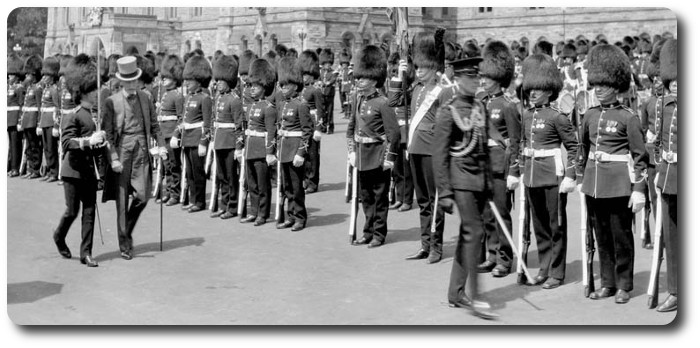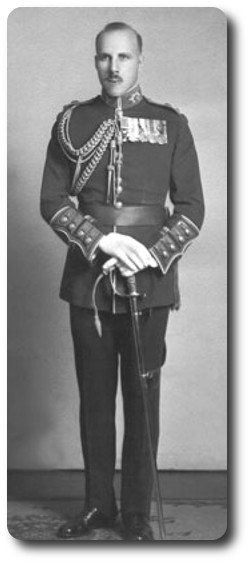Topic: Canadian Militia
 The Governor General's Foot Guards on parade, 1927.
The Governor General's Foot Guards on parade, 1927.
Colonel Topp Now Gazetted O.C. of Guards
Col. R.F. Parkinson Goes to Reserve of Officers After Four Years at Head of Crack Regiment
Mentioned for Brigade Command before Long
New Commanding Officer Serving With Distinction During Great War
The Ottawa Citizen; 12 April 1926
C.B. Topp

C. Beresford Topp was born in Bracebridge, Ontario. He served in both the First and Second World Wars and was wounded three times in the First, when he was awarded the Distinguished Service Order and bar and the Military Cross and bar as an officer of the 42nd Battalion, CEF (Royal Highlanders of Canada). For his services in the Second World War he was awarded the Order of the British Empire. He became commandant at Lansdowne Park, Ottawa, during WW II. He was secretary of the Pensions Appeal Board from 1924 to 1935 and a member of the pensions commission from 1956 to 1964. Upon his death in 1976 he held the rank of Brigadier- General.
Lt.-Col. R.F. Parkinson, D.S.O., for the past four years the commanding officer of the Governor General's Foot Guards, ceases to command that regiment as from October 4 last, and major C.B. Topp, D.S.O., M.C., is promoted to Lt.-Colonel commanding the regiment.
Lt.-Col. Parkinson has completed the prescribed three years in command and an extra year by request. He thus automatically goes on the reserve list, is slated, it is understood from unofficial sources, for a brigade command in the neat future.
Lt.-Col. Parkinson has completed twenty-five years in the active militia of Canada, having enlisted first in the Collegiate Institute Cadet Corps of Woodstock, Ont., and later the 22nd Regiment, Oxford Rifles. On coming to Ottawa, he was given a commission in the 43rd Regiment Duke of Cornwall's Own Rifles, in which corps he had attained the rank of captain in 1914 with the command of “F” Company.
On Active Service
At the end of 1914, when the 38th Battalion of the Canadian Expeditionary Force was being organized in Ottawa, he was appointed captain and had the responsibility of organizing and mobilizing “A” Company of that unit, the recruits for which came largely from the 43rd Regiment.
Later, in the field, he filled the posts of company commander, with the rank of major, adjutant and second-in-command of the 35th Battalion, and after Vimy Ridge, 1917, commanded the battalion at various times in 1918, and in September of that year he was appointed to the personal staff of Canada's minister in England, Sir Edward Kemp. At the same time in addition to secretarial duties he became director of the Canadian War Records in succession to Lord Beaverbrook.
In Command G.G.F.G.
Lt.-Col. Parkinson returned to Canada in 1919 and was demobilized in June of that year. He was mentioned in despatches in June, 1917, and June, 1918. also being awarded the Distinguished Service Order in 1918.
The colonel actively identifying himself with the reorganization of the Governor General's Foot Guards in 1930, was, on October 4, 1921, gazetted to command the crack regiment of the Capital. After serving the prescribed three year term he was requested, in view of past service, to accept a year's extension, the expiration of which now marks the change in command.
While he commanded the regiment the Governor General's Foot Guards established a record among Canadian regiments for rifle shooting, winning, in addition to the majority of team prizes at the big rile shooting competitions, such individual wins as the King's Prize and the Governor General's Medal. In addition the regiment secured more places on the Canadian Bisley team than any other single unit.
It was during Lt.-Col. Parkinson's regime that the regiment celebrated its 50th anniversary.
Guards' New O.C.
Lt.-Colonel C.B. Topp. D.S.O., M.C., new commanding officer of the Governor General's Foot Guards, was, at the outbreak of the war, a member of the editorial staff of the Toronto Mail and Empire. He proceeded to France with the first Canadian Division as a war correspondent. Shortly after his arrival in France he resigned from the staff of the Mail and Empire in order to join the fighting forces. After receiving a commission as a lieutenant he became an officer of the 42nd Highlanders of Montreal and served with distinction with that unit during 1916, 1917 and 1918, having the honor to command that famous battalion at various intervals, including the final days of the great struggle. He was wounded three times, and for his conspicuously gallant services was awarded the D.S.O. and the Military Cross and bar in additions to being mentioned in despatches.
Returning to Canada, Lt.-Col. Topp assumed charge of the Returned Soldiers' Branch of the D.S.C.R., and organized this important undertaking and remained in charge of administration until the period during which the returned soldiers' insurance was being given was ended. He then became secretary of the Federal Appeal Board, holding this post at the time of his present appointment.
At the present time in addition, he is an acting commissioner of the Federal Appeal Board.

